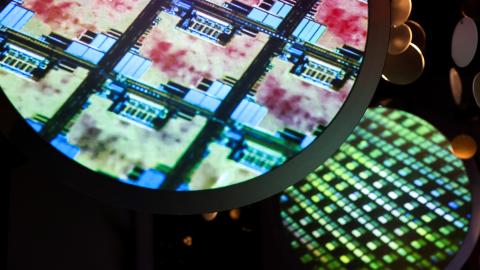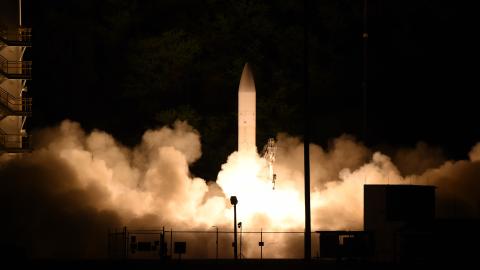Hudson Institute and Space Foundation cohosted a workshop with Congressmen Doug Lamborn (R-CO), Vince Fong (R-CA), and Donald Norcross (D-NJ), Admiral James A. Winnefeld Jr., and former Office of the Secretary of Defense officials Mike White and John Plumb to discuss the future of the United States military’s hypersonic missile and missile defeat programs.
Their five key takeaways are below.
Watch the event, read the full transcript, or listen here.
1. Hypersonic capabilities are vital to deter and, if necessary, defeat adversaries.
“I think it’s destabilizing to let a significant capability be in the hands of adversaries and us not to have that same capability.”
“Our military commanders tell us that they will need to potentially strike a specific set of highly important targets, that are at a great distance, early in a conflict, with a high degree of confidence of success. Right now, we only have slow cruise missiles with limited range or ballistic missiles with predictable trajectories. These weapons will not get the job done when the enemy has a full magazine of missile defense interceptors. We need something that can go fast, go far, and evade defenses.”
“I would say that when Xi Jinping or Vladimir Putin wake up in the morning and thinks about, ‘Okay, I’m going to make my big move today.’ You want them to say, ‘Well, maybe not today.’”
“And so hypersonics, in that regard, present a very special element of deterrence that I think is really important. And that goes for our allies as well, I mean, we’re all in this together and they either need to know we’ve got the capability or they need to develop it themselves or, better, co-develop it, so we can get that deterrent value from these systems.”
“And then once you actually get into this conflict, whether it’s with Russia or China, it’s probably going to be a long slog of a war. And you need to have scale and you need to be able to have aircraft, F-15s, F-18s, what have you, carry weapons that can fly. Maybe not as far as a Conventional Prompt Strike or an ARRW [Air-Launched Rapid Response Weapon], but can go really, really fast for emergent targets, for targets that are heavily defended. So, you have that penetration capability. And that’s where the air breathers, I think, come in. And those have to be produced at massive scale.”
— Admiral James A. Winnefeld Jr.
2. American forces and the US defense industry need to learn how to defend against hypersonic missiles.
“The first time one of our troops—whether Air Force, Navy, Marine Corps, Space Force, you name it—sees a hypersonic weapon cannot be in combat. And the example I would give you is as a young mid-grade F-14 pilot, I lucked into this situation where I was able to attempt to track and simulate an engagement on an SR-71. . . . It was an order of magnitude more difficult than anything I’d ever done in terms of intercepting something or trying to intercept something. And that was only going Mach 3.”
— Admiral James A. Winnefeld Jr.
“Fundamental to our defense is developing sensors that can provide quality fire control data to our effectors. I was pleased to see HBTSS [the Hypersonic and Ballistic Tracking Space Sensor] launched earlier this year, but we must build on that capability by fully transitioning these sensors and the fire control quality data they provide to the proliferated warfighting space architecture.”
“Investing in these kinds of sensors would be futile without effectors that can close the kill chain faster and at a greater distance. . . . That is why I pushed to accelerate the development of the Glide Phase Interceptor [GPI] in the National Defense Authorization Act. The law directs the Department of Defense to field this system by 2029.”
“The Glide Phase Interceptor concept pushes that kind of defense range out farther, so you have more shot opportunities; you can increase your defense range. So I think the need for both is relatively straightforward. As far as the idea of using glide phase intercept to force maneuvers on an incoming weapon. . . . generally speaking, if a missile’s maneuvering, it’s increasing its drag, increasing its thermal load, and so then maybe it reduces its ability to maneuver an endgame. Its speed and endgame make a terminal shot more likely for success.”
— Former Assistant Secretary of Defense for Space Policy John Plumb
3. The US needs to scale its advanced defense industrial base.
“We do not test enough, and we don’t test in the right way. Earlier this year, my subcommittee heard from George Rumford, the director of the Test Resource Management Center, or TRMC. He testified that he would like to do a flight test every week to mature our hypersonics program. I agree with him. This is vital. But right now, we hardly test every quarter. We need to start flying more often and get comfortable with incurring risks that are associated with a higher test cadence.”
“One of my top priorities in this year’s NDAA was to bolster the Mach-TB program. I believe the Pentagon needs to fully resource this as a program of record next year. If it does not, Congress should mandate it in the NDAA to include forcing the DoD to provide a full resource portfolio for it.”
“As my colleague said, if we learned anything from the pandemic, we are too reliant on China and other countries for the things that we need. And so this conversation about onshoring, bringing manufacturing back to the United States. We have to be able to develop that here in America, or with our allied partners, that actually care about the values that we share as a country.”
“I would point out a couple of situations that actually call for the different types of hypersonic weapons we have. . . . If there’s a target early on in a conflict that is sort of a disproportional capability, that’s a point target that you really want to take out as quickly as you possibly can, as early in the conflict as you possibly can, and you need to do it from a distance, you pretty much need to have a hypersonic capability that is probably a boost-glide system because your forces may not have closed yet, and you may be trying to take these things out while your forces are closing, which really argues for systems like Conventional Prompt Strike, for ARRW, things like that.”
— Admiral James A. Winnefeld Jr.
4. To accelerate development, Washington needs to remove restrictions on cooperating with allies.
“We’re not in an arms race, which means we’re not going to build 10 hypersonic weapons just because the Chinese have 10 hypersonic weapons. But we are in a capability race in my mind, and that is: we are facing a very aggressive A2/AD [anti-access/area denial] strategy, and we have to have the capability to defeat that defensive posture. And so we are in a capability race to field [a] capability that defeats the defenses of the adversary that hold out our traditional systems. And that’s the criticality of what we need and why we need it from that perspective. And bringing our allies on board to accelerate the maturation of the capability and then work with us to accelerate the fielding in numbers is going to be critical.”
— Former Principal Director for Hypersonics in the Office of the Secretary of Defense Mike White
“We’re doing some good things with testing, and I mentioned over land as opposed to over water. This is something where a partner like Australia might even be able to help.”
“We’re talking about a layered defense and what will take place in the defense of Guam. . . . So having partner countries, Japan, Philippines, Australia, Japan, South Korea—incredibly important when we’re trying to forward deploy many of the things that we would need if there was conflict to break out. But first and foremost is to protect Americans and American assets. And it starts with Guam.”
5. Washington also needs to limit regulations and empower the private sector.
“The MTCR [Missile Technology Control Regime] moves with the speed of bureaucracy.”
— Admiral James A. Winnefeld Jr.
“Particularly when you’re doing it on a private side, FAA [the Federal Aviation Administration] now has their foot in the door, and actually is creating some difficulties . . . just by slowing things down. They are not accustomed to dealing with these issues, and it has put a real time stamp on some of the launches that need to occur over the course of the next two years.”
“When you talk about the commercial space, I mean, we have to learn some hard lessons in terms of how we apply it to hypersonics. Now that SpaceX is one of the partners that helps us launch DoD and other sensitive missions into space, space is going to be the next frontier for us. And so having the commercial-DoD public-private partnership—that’s critical for us, especially with the need to increase our cadence and launches.”




















